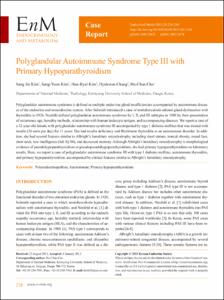KUMEL Repository
1. Journal Papers (연구논문)
1. School of Medicine (의과대학)
Dept. of Internal Medicine (내과학)
Polyglandular Autoimmune Syndrome Type Ⅲ with Primary Hypoparathyroidism
- Keimyung Author(s)
- Cho, Ho Chan; Chang, Hyuk Won
- Journal Title
- Endocrinology and Metabolism
- Issued Date
- 2013
- Volume
- 28
- Issue
- 3
- Abstract
- Polyglandular autoimmune syndrome is defined as multiple endocrine gland insufficiencies accompanied by autoimmune diseases
of the endocrine and nonendocrine system. After Schmidt introduced a case of nontuberculosis adrenal gland dysfunction with
thyroiditis in 1926, Neufeld defined polyglandular autoimmune syndrome by I, II, and III subtypes in 1980 by their presentation
of occurrence age, heredity methods, relationship with human leukocyte antigen, and accompanying diseases. We report a case of
a 32-year-old female with polyglandular autoimmune syndrome III accompanied by type 1 diabetes mellitus that was treated with
insulin (36 units per day) for 11 years. She had insulin deficiency and Hashimoto thyroiditis as an autoimmune disorder. In addition,
she had several features similar to Albright’s hereditary osteodystrophy including short stature, truncal obesity, round face,
short neck, low intelligence (full IQ 84), and decreased memory. Although Albright’s hereditary osteodystrophy is morphological
evidence of pseudohypoparathyroidism or pseudopseudohypoparathyroidism, she had primary hypoparathyroidism on laboratory
results. Here, we report a case of polyglandular autoimmune syndrome III with type 1 diabetes mellitus, autoimmune thyroiditis,
and primary hypoparathyroidism, accompanied by clinical features similar to Albright’s hereditary osteodystrophy.
- Publisher
- School of Medicine
- Citation
- Sang Jin Kim et al. (2013). Polyglandular Autoimmune Syndrome Type Ⅲ with
Primary Hypoparathyroidism. Endocrinology and Metabolism, 28(3), 236–240. doi: 10.3803/EnM.2013.28.3.236
- Type
- Article
- ISSN
- 2093-596X
- Appears in Collections:
- 1. School of Medicine (의과대학) > Dept. of Internal Medicine (내과학)
1. School of Medicine (의과대학) > Dept. of Radiology (영상의학)
- 파일 목록
-
-
Download
 oak-aaa-01691.pdf
기타 데이터 / 415.95 kB / Adobe PDF
oak-aaa-01691.pdf
기타 데이터 / 415.95 kB / Adobe PDF
-
Items in Repository are protected by copyright, with all rights reserved, unless otherwise indicated.